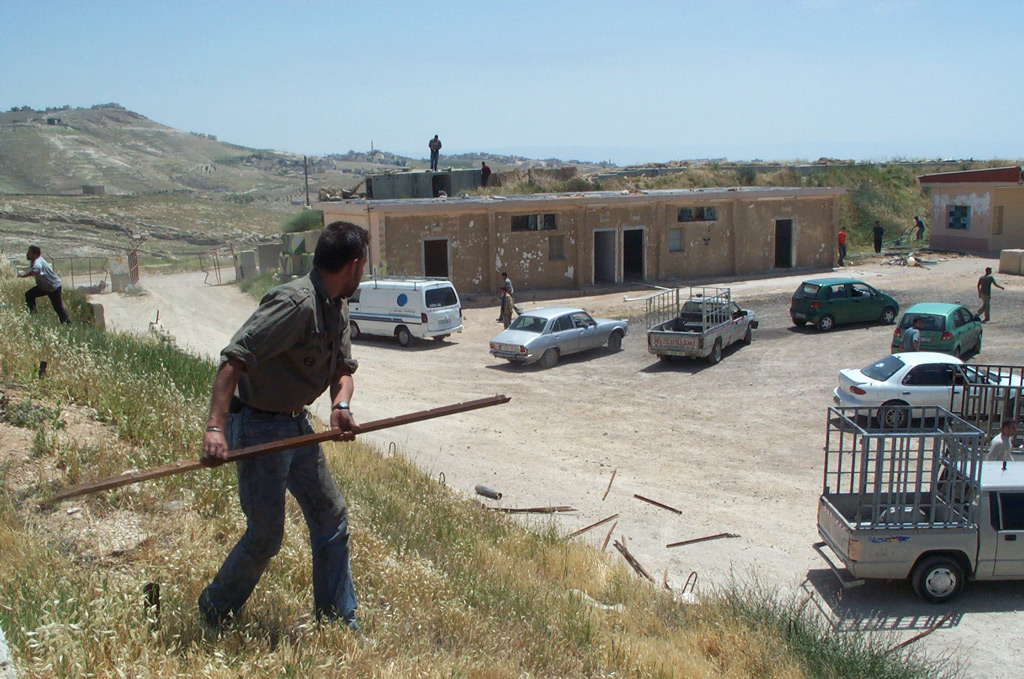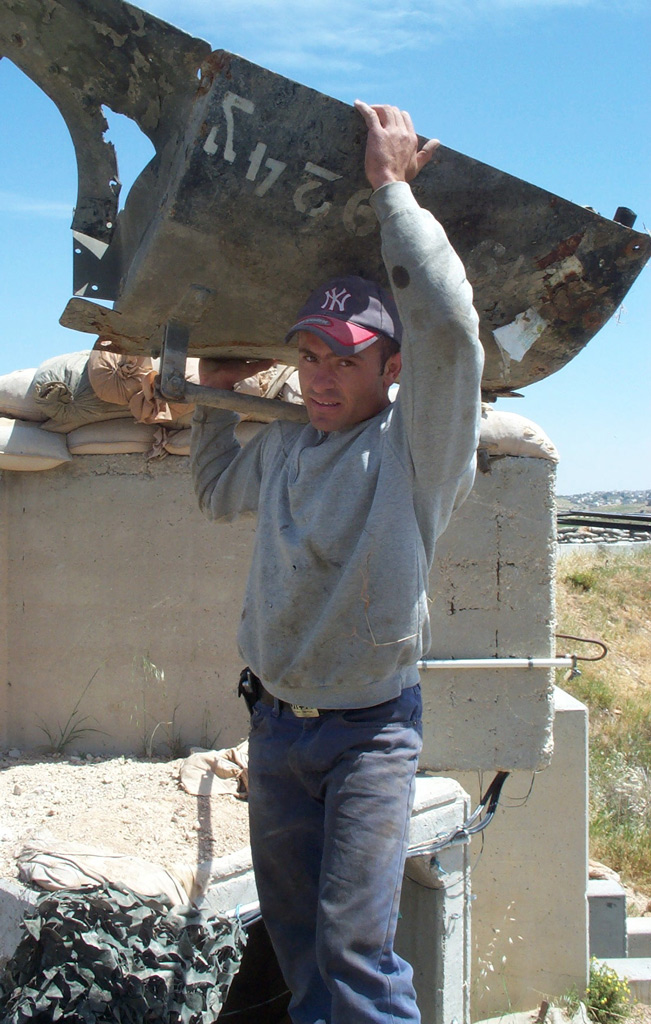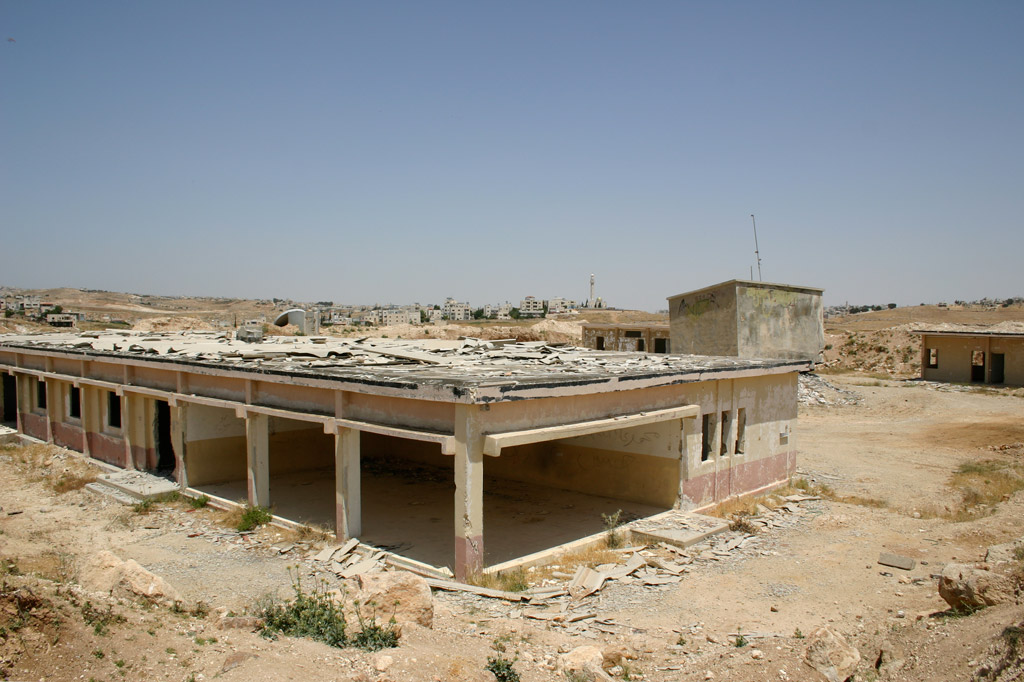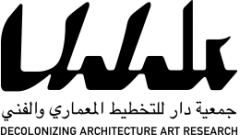From Les damnés de la terre, Frantz Fanon (1961):
Violent act
National liberation, national reawakening, the restoration of nationhood to the people or Commonwealth, whatever the name used, whatever the latest expression, decolonization is always a violent event. At whatever level we study it […] decolonization is quite simply the substitution of one ‘species’ of mankind by another. The substitution is unconditional, absolute, total and seamless. […]
Tabula rasa
To destroy the colonial world means nothing less than demolishing the colonist’s city, burying it deep within the earth or banishing it from the territory.


Photos by IMEMC
 The military camp at Oush Grab after being partly demolished by Palestinians
The military camp at Oush Grab after being partly demolished by Palestinians
Eyal Weizman:
You cannot think of transformation of space without a moment of transgression, of revolution. This moment is necessary in our process of decolonization. You cannot think of this moment without some destruction of the buildings. This was very clear in the military camp. The first moment of access is as well the first moment of transgression. This decolonizing moment is something that we cannot and should not control. The worst thing on our part would be to say to people, “Ok, you have access but now we are going to control it”. There needs be this moment of spontaneity. This recalls the evacuation of Gaza. The only thing that was not destroyed by Israel were the synagogues. The Israeli court decided they must be left. When the Palestinians came into the settlements these synagogues were destroyed. This project has a kind of inbuilt paradox: we are designing on an indeterminate plane. We do not know what happens after the access. Destruction? Perhaps… We are at the point of indeterminacy, because we cannot attempt to control this moment. The Palestinians need to enter the settlement and do whatever they want.
We call this transgression because it is the moment between the transfer of one set of laws to another set of laws. It is the most architectural moment, it is the most spontaneous moment in anyone’s relation to architecture. In Gaza, James Wolfenson took half a million dollars of his own money and collected some more to buy the greenhouses from the settlements to give to the Palestinians. When the Palestinians had access to the settlements, they destroyed them. Although they were bought for them and they could have used them, there was nothing else to destroy. This is not a moment of rationality, of planning for the future. It is a spontaneous outbreak. Some people I spoke with in Gaza described it as a kind of exorcism.
This revolutionary moment is a crucial moment and any project that deals with the settlements will have to address this point. In some ways I have been trying to avoid it. I was hoping that maybe the new Palestinian Authority would be ready for this moment and that people will not have to be violent and this transgression will not be necessary.
EW:
Historically, there is seldom change from one system to another without an act which is somehow violent. It need not be physically or spectacularly violent, but there is a kind of break.
It is an unpredictable moment of excess, of interference. The site we imagine now is not the site that we will get. If we were working like ARIJ, in a very institutional manner, we would be missing the crucial moment of transition. The last thing we should do is to intervene or define this unpredictability. But we do not know, the act of destruction could be done by the Israelis, could be done by the Palestinians, it could be done by both sequentially or simultaneously.
Sandi Hilal:
Exactly what we were discussing at the military camp. Looking at the destruction of the buildings we thought at first that the Israelis destroyed them, but then we thought it could have been done by the Palestinians. It was a kind of confusion, because both of them could have done it.
Alessandro Petti:
It will be a chaotic moment; there is a tension in the society that could be violent or unpredictable. At the same time, the action also could be categorized as re-appropriation or constructive. I imagine there will be some destructive actions, based on frustration, but there will also be some practices where you can already see the re-appropriation of the space. The idea that now you can have new life here. Gaza needs to be investigated in these terms. The act of destruction is also the moment that they very practically stole things, not for ideology or frustration, but to reuse.
EW:
The destruction of the settlements appears in houses in Gaza. You can see pieces of the red tiles, doorframes, and window frames all reused in Gaza houses.
AP:
This is re-appropriation, not destruction. When there was this moment in Gaza, the majority of people were transgressing this barrier, in a very positive way. At the same time there were people shooting in the air and yelling, and it almost devastated this moment of transgression, which alone was quite strong. When you do something new, you have people only interested in devastation. Because some people have access to weapons, means they could also force a kind of repression again on people.
EW:
Think about why people would destroy their own greenhouses, greenhouses that were bought for them. Because they don’t accept the order that has been put on them, they don’t accept the World Bank or their deal. Even in this completely chaotic moment there is a real power and meaning to this.
AP:
How do you then activate a kind of positive practice in this moment?
EW:
For me the destruction of the settlements could be a positive start, especially if you think of it as the first stage in the transformation of the built environment. This is the break; a radically different moment.
This undoes the traditional terms of planning and architecture. Architecture needs some ground of determinacy: site, timeframe, and budget. Here we operate with maximum indeterminacy. How do you put design energy into such indeterminacy? This is the reason that our design seeks to intervene in the field of cultural sensibility which is a public, cultural and political category. It is seeking to explore the possibility of transformation. Whenever it happens, there will be a theoretical thinking that has developed and that allows us to approach the situation in certain ways. Against the field of indeterminacy our approach is to define the field of the possible, to imagine what is possible.
SH:
Paradoxically, one of the perceived strengths of this project is that it plans ahead. As Palestinians we are always reacting and in this project we are planning.
AP:
What could be our strategy? What can we plan? Because if we have too many ideas in this determinacy, then we cannot plan. Where we will enter in the project? What are the basic structures that will allow us to present some evidence. How will this integrity be used?
I’ve seen many places, modernist and very rational, places planned for two families and kids and used in a very different way. Planning does not always determine how the space will be used. In the settlements we would be using very determinate structures and turning them into more flexible spaces.
SH:
Again, I think it is important to see architecture as an arena of speculation. From the moment we start working with NGOs on the ground, with certain examples. Would this determine the moment of the break? We can’t expect that because of the NGOs and the people on the ground, the revolutionary moment will not happen. But it might influence it or raise questions. Does architecture as speculation determine historical moments? Is the project aiming to intervene on this moment, directly or indirectly?
EW:
There are 700,000 buildings that Israel has put in the Occupied Palestinian Territories. We don’t have stop at the Occupied Territories; there are a number of community settlements inside Israel that justifiably should be decolonized. But the numbers of typologies of the buildings are very limited, so the intervention on specific details – doors, windows – allows political work on a different scale. It is like affecting politics on the level of atoms.
